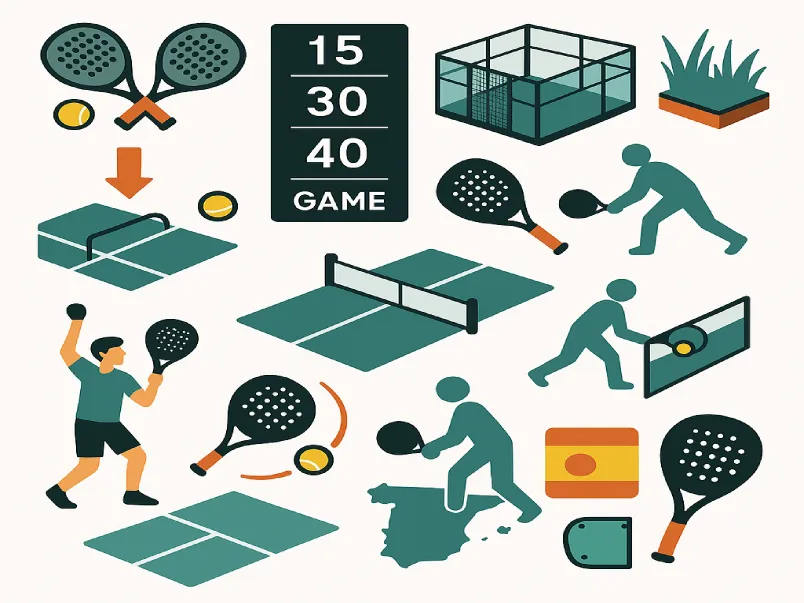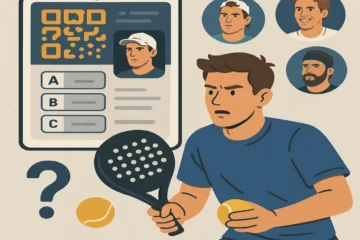You’ve felt the thrill of a perfect ‘bandeja,’ laughed at a crazy ‘wall shot,’ and love the social vibe on the padel court. But how well do you really know the rules, history, and nuances of the world’s fastest-growing sport?
It’s time to find out! Grab your racket (figuratively) and get ready for our ultimate Padel Quiz. Will you ace it and claim your title as a Padel Pro, or will you discover you’re still a Rookie in training?
Let’s get started! No peeking at the answers!
The Padel Quiz
Part 1: The Basics (Rookie Level)
Q1: What is the standard scoring system in padel?
a) 1, 2, 3, Game
b) 15, 30, 40, Game
c) Love, 5, 10, Win
Q2: A standard padel court includes which key feature?
a) A net and a single wall at the back.
b) Walls of glass and metallic mesh on all sides.
c) No net, but a high wall around the entire court.
Q3: What is the primary material used for the surface of a padel court?
a) Grass
b) Clay
c) Artificial Turf
Part 2: Rules & Gameplay (Intermediate Level)
Q4: The ball must always…
a) Bounce on the ground before hitting any wall.
b) Be hit directly out of the air without a bounce.
c) Bounce on the ground once before you can return it, but it can then hit the walls.
Q5: When serving, the ball must bounce…
a) Anywhere in the opponent’s service box.
b) Behind the service line after it’s been hit.
c) Inside the service box without touching the surrounding metal mesh.
Q6: What is the “Golden Rule” of padel positioning for a team?
a) One at the net, one at the back.
b) Always stay side-by-side.
c) Both players should move up and back together as a unit.
Part 3: Technique & Shots (Advanced Level)
Q7: The “Bandeja” is primarily used to:
a) End the point with power and speed.
b) Defend a lob and regain net position with control.
c) Hit a tricky, spinning drop shot.
Q8: A “Vibora” is different from a “Bandeja” because it involves more:
a) Height and patience.
b) Wrist action and sidespin.
c) Power from the shoulder.
Q9: From where on the court is a “Chiquita” most effectively played?
a) From the very back wall.
b) From the middle of the court.
c) From the net, as a volley.
Part 4: History & Trivia (Expert Level)
Q10: In which country was padel invented?
a) Spain
b) Mexico
c) Argentina
Q11: What is a unique characteristic of a padel racket compared to a tennis racket?
a) It is stringless, made of a solid, perforated surface.
b) It is much longer and heavier.
c) It has double the number of strings.
Q12: Which of these is NOT a common fault?
a) Hitting the ball into your own wall before it goes over the net.
b) Touching the net with your racket during a point.
c) The ball bouncing twice on your side.
Answer Key & Explanations
Q1: What is the standard scoring system in padel?
Answer: b) 15, 30, 40, Game
Explanation: Just like tennis, padel follows the traditional tennis scoring system: 15, 30, 40, and Game. The set is won by the team that first wins 6 games, but they must lead by at least 2 games.
Q2: A standard padel court includes which key feature?
Answer: b) Walls of glass and metallic mesh on all sides.
Explanation: A standard padel court has walls made of glass and metallic mesh on all four sides, creating the characteristic “enclosed” environment where players can use the walls strategically in their shots.
Q3: What is the primary material used for the surface of a padel court?
Answer: c) Artificial Turf
Explanation: The surface of a padel court is usually made of artificial turf. This synthetic material provides a consistent, smooth playing surface and allows for the ball to bounce predictably.
Q4: The ball must always…
Answer: c) Bounce on the ground once before you can return it, but it can then hit the walls.
Explanation: The ball must bounce once on the ground before a player can return it, but after that, the ball is allowed to hit the glass walls or mesh fences. This rule makes padel a unique and dynamic sport.
Q5: When serving, the ball must bounce…
Answer: c) Inside the service box without touching the surrounding metal mesh.
Explanation: During the serve, the ball must bounce in the designated service box and cannot touch the surrounding metal mesh. The serve must be underhand and hit below the waist.
Q6: What is the “Golden Rule” of padel positioning for a team?
Answer: a) One at the net, one at the back.
Explanation: The most effective positioning for a team in padel is to have one player at the net, controlling the play and putting pressure on the opponents, while the other player stays at the back to cover the court and return difficult shots.
Q7: The “Bandeja” is primarily used to:
Answer: b) Defend a lob and regain net position with control.
Explanation: The “Bandeja” is a defensive shot, typically used after the opponent hits a lob. It’s a controlled, slicing shot that allows the player to regain their position at the net.
Q8: A “Vibora” is different from a “Bandeja” because it involves more:
Answer: b) Wrist action and sidespin.
Explanation: The “Vibora” is a more aggressive shot than the “Bandeja.” It involves significant wrist action and sidespin, creating a sharp curve that makes it harder for the opponent to return.
Q9: From where on the court is a “Chiquita” most effectively played?
Answer: c) From the net, as a volley.
Explanation: The “Chiquita” is a delicate shot used from the net, typically when you want to drop the ball just over the opponent’s head. It’s often used to change the pace and surprise the opponent.
Q10: In which country was padel invented?
Answer: a) Spain
Explanation: Padel was invented in 1969 in Spain by Enrique Corcuera. It quickly became popular, especially in countries like Spain and Argentina, before spreading to the rest of the world.
Q11: What is a unique characteristic of a padel racket compared to a tennis racket?
Answer: a) It is stringless, made of a solid, perforated surface.
Explanation: Unlike a tennis racket, a padel racket is solid and perforated, with no strings. The holes reduce air resistance and make the racket more maneuverable.
Q12: Which of these is NOT a common fault?
Answer: a) Hitting the ball into your own wall before it goes over the net.
Explanation: A common fault in padel includes touching the net with your racket or having the ball bounce twice on your side of the court. However, hitting the ball into your own wall before it crosses the net is not a fault under standard padel rules.
Scoring & Results
0-3 Correct: Padel Rookie
Fun Verdict: Don’t worry! Everyone starts somewhere. Get out on the court, and this rules knowledge will come naturally. Keep playing!
4-7 Correct: Padel Enthusiast
Fun Verdict: You’ve got a solid foundation! You understand the basics and some key strategies. A few more matches and you’ll be in the pro league.
8-10 Correct: Padel Strategist
Fun Verdict: Impressive! You not only play but you think the game. Your knowledge of shots and tactics shows you’re a true student of padel.
11-12 Correct: Padel Pro
Fun Verdict: Wow! Are you secretly a WPT player? Your knowledge is top-tier. You’re the go-to person on your court for rules and technique advice.
Conclusion & Social Sharing Prompt
So, how did you score? Whether you’re a Rookie or a Pro, the most important part of padel is having fun and enjoying the game.
Challenge your padel partner or your club friends! Share your score in the comments below or tag a friend you think you can beat on social media.
Happy playing, and see you on the court!
FAQs
1. What is padel?
Padel is a popular racquet sport that combines elements of tennis and squash. It is typically played in doubles on an enclosed court with glass and mesh walls. The objective is to hit the ball over the net, using walls as part of the game, with the aim of making the ball bounce twice on the opponent’s side.
2. How do you score in padel?
Padel uses the same scoring system as tennis: 15, 30, 40, and Game. A set is won by the first team to reach six games, with a two-game advantage required. If the score reaches 6-6, a tiebreaker is played.
3. What equipment do you need to play padel?
The essential equipment for playing padel includes a padel racket, which is perforated and stringless, and a padel ball. Players typically wear comfortable athletic shoes designed for court play.
4. How does serving work in padel?
In padel, the serve is always underhand and must bounce in the designated service box before crossing the net. It is essential that the ball does not touch the surrounding metal mesh or walls when serving.
5. What are the basic rules of padel?
The basic rules of padel include:
- The ball must bounce on your side of the court before it can hit any wall.
- Players use the walls to return the ball, but it must always bounce first on the ground.
- The game is played in doubles, with each team of two players alternating turns to hit the ball.
6. What is a “Bandeja” in padel?
The “Bandeja” is a defensive shot in padel used to defend a lob and regain control of the net position. It is typically hit with a slicing motion, maintaining a controlled trajectory to keep the ball within the court boundaries.
7. What is the origin of padel?
Padel was invented in 1969 in Spain by Enrique Corcuera. It quickly gained popularity in Spain and Argentina and is now played worldwide.
8. Is padel the same as tennis?
Although padel shares some similarities with tennis, such as the scoring system and the use of rackets, it is played in a smaller, enclosed court, and the ball is allowed to bounce off walls. The game also emphasizes teamwork and strategy, especially when playing doubles.


